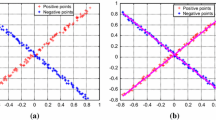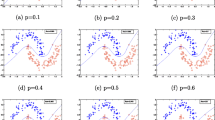Abstract
Twin support vector machine and many of its variants proposed recently generate two optimal separating hyperplanes by solving two dual constrained quadratic programming problems (QPPs) independently. However, each dual QPP involves a set of dual variables with its size determined by the number of patterns in the other class. This will lead to prohibitively computational complexity when these models are encountered with large-scale datasets. In this paper, we propose an improved twin support vector machine, termed as fixed-point twin support vector machine, in which each dual QPP in the traditional TWSVM and its variants in high dimensional space is converted into a sequence of successive minimization problems of unimodal functions in one dimension which can be solved by using line search methods like the Fibonacci search method or the golden section rule. Numerical experiments on several benchmark datasets including large-scale datasets are performed to verify the validity of our proposed algorithm. Experimental results indicate that the our model gains faster training speed while maintaining comparable classification accuracy.



Similar content being viewed by others
References
Cortes, C., Vapnik, V.N.: Support-vector networks. Mach. Learn. 20(3), 273–297 (1995)
Mangasarian, O.L.: Nonlinear Programming. SIAM, Philadelphia (1994)
Abe, S.: Support Vector Machines for Pattern Classification. Springer, Berlin (2005)
Noble, W.S.: Support vector machien applications in computational biology. In: Scholkopf, B., Tsuda, K., Vert, J.-P. (eds.) Kernel Methods in Computational Biology. MIT Press, Cambridge (2004)
Lal, T.N., Schroder, M., Hinterberger, T., weston, J., Bogdan, M., Birbaumer, N., Scholkopf, B.: Support vector channel selection in BCI. IEEE Trans. Biomed. Eng. 51(6), 1003–1010 (2004)
Trafalis, T. B., Ince, H.: Support vector machine for regression and applications to financial forecasting. In: Proceedings of the IEEE-INNS-ENNS International Joint Neural Networks, vol. 6. Como, Italy, pp. 348–353 (July 2000)
Shawe-Taylor, J., Cristianini, N.: Kernel Methods for Pattern Analysis. Cambridge University Press, Cambridge (2004)
Jayadeva, R.K., Chandra, S.: Twin support vector machines for pattern classification. IEEE Trans. Pattern Anal. Mach. Intell. 29, 905–910 (2007)
Shao, Y.H., Zhang, C.H., Wang, X.B., Deng, N.Y.: Improvements on twin support vector machines. IEEE Trans. Neural Netw. 22, 962–968 (2011)
Tian, Y., Ju, X., Qi, Z., Shi, Y.: Improved twin support vector machine. Sci. China 57, 417–432 (2014)
Peng, X.J.: A v-twin support vector machine (v-TWSVM) classifier and its geometric algorithms. Inf. Sci. 180, 3863–3875 (2010)
Peng, X.: Least squares twin support vector hypersphere (LS-TSVH) for pattern recognition. Expert Syst. Appl. 37, 8371–8378 (2010)
Peng, X., Xu, D.: A twin-hypersphere support vector machine classifier and the fast learning algorithm. Inf. Sci. 221, 12–27 (2013)
Xu, Y., Yang, Z., Zhang, Y., Pan, X., Wang, L.: A maximum margin and minimum volume hyper-spheres machine with pinball loss for imbalanced data classification. Knowl.-Based Syst. 95, 75–85 (2016)
Peng, X., Kong, L., Chen, D.: A structural information-based twin-hypersphere support vector machine classifier. Int. J. Mach. Learn. Cybern. 8(1), 295–308 (2017)
Pan, X., Luo, Y., Xu, Y.: K-nearest neighbor based structural twin support vector machine. Knowl.-Based Syst. 88, 34–44 (2015)
Xu, Y., Wang, L., Zhong, P.: A rough margin-based v-twin support vector machine. Neural Comput. Appl. 21, 1307–1317 (2012)
Wang, H., Zhou, Z.: An improved rough margin-based v-twin bounded support vector machine. Knowl.-Based Syst. 128, 125–128 (2017)
Cao, L., Shen, H.: Combining Re-sampling with twin support vector machine for imbalanced data classification. In: 2016 17th International Conference on Parallel and Distributed Computing, Applications and Technologies, pp. 325–329 (2016)
Cao, Q., Fu, X., Guo, Y.: Fuzzy chance constrained twin support vector machine for uncertain classification. In: ICMSEM 2017 Proceedings of the Eleventh International Conference on Management Science and Engineering Management, pp 1508–1521 (2017)
Khemchandani, R.: Mathematical programming applications in machine learning. (Ph.D.thesis), New Delhi-110016, Indea: Inddian Institute of Technology Delhi (2008)
Fung, G., Mangasarian, O.L.: Proximal support vector machines. In: Proceedings of the Seventh International Conference Knowledge Discovery and Data Mining, pp. 77–86 (2001)
Cristianini, N., Shawe-Taylor, J.: An Introduction to Support Vector Machines. Cambridge University Press, Cambridge (2000)
Lin, C.-J.: Stopping criteria of decomposition methods for support vector machines: a theoretical justification. Technical report, Department of Computer Science and Information Engineering, National Taiwan University, (May 2001)
Lin, C.J., Hus, C.-W., Chang, C.-C.: A practical guide to support vector classification. National Taiwan University. www.csie.ntu.edu.tw/cjlin/papaers/guide/guide.pdf (2003)
Duda, R.O., Hart, P.E., Stork, D.G.: Pattern Classification. Wiley, New York (2012)
Blake, C., Merz, C.J.: UCI repository of machine learning databases. http://www.ics.uci.edu/~mlearn/MLRepository.html (1998)
Musicant, D.: NDC: normally distributed clustered datasets. Computer Sciences Department, University of Wisconsin, Madison. http://www.cswisc.edu/~musicant/data/ndc (1998)
Johnson, N.L., Kotz, S., Balakrishnan, N.: Lognormal distributions. In Continuous univariate distributions, vol. 1 (1994)
Acknowledgements
This work was supported by the National High Technology Research and Development Program of China(863 Program)(2011AA010706), the National Natural Science Foundation of China (61133016, 61272527), and Ministry of Education-China Mobile Communications Corporation Research Funds (MCM20121041).
Author information
Authors and Affiliations
Corresponding author
Rights and permissions
About this article
Cite this article
Fang, J., Liu, Q. & Qin, Z. Fixed-point twin support vector machine. Cluster Comput 22 (Suppl 4), 7991–8005 (2019). https://doi.org/10.1007/s10586-017-1572-2
Received:
Revised:
Accepted:
Published:
Issue Date:
DOI: https://doi.org/10.1007/s10586-017-1572-2




